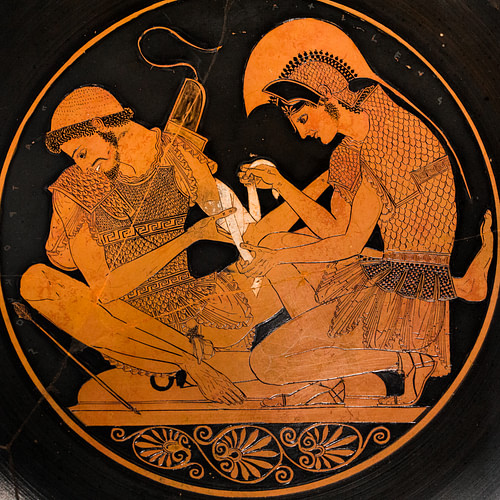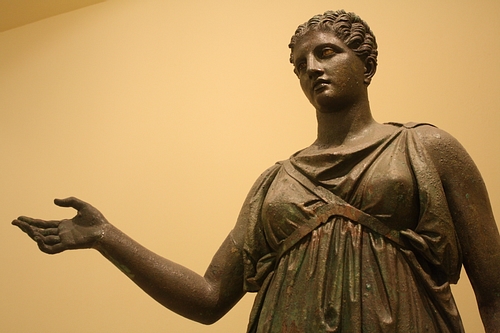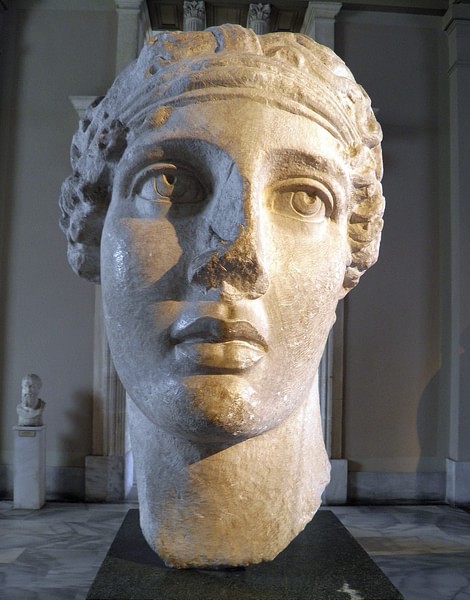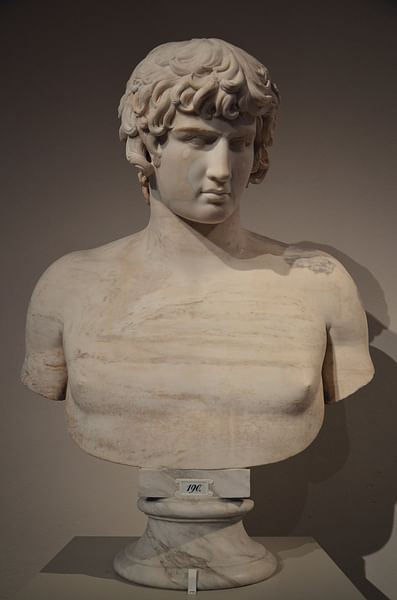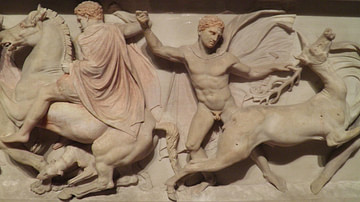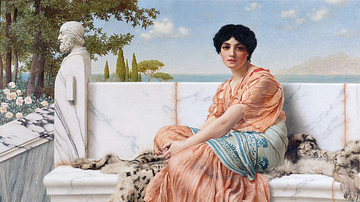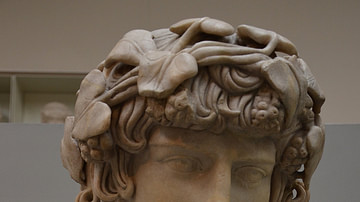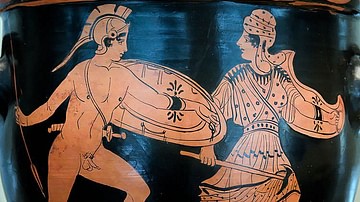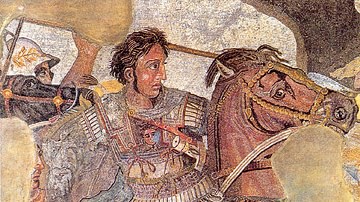History is recorded by individual human beings with their own beliefs and interests guiding what they choose to record, and, as such, many events and details may be omitted from the account of a certain event or the story of a great person’s life. This is especially so when considering so-called "gay history".
"Gay history", of course, is just history which includes mention of an individual’s sexual orientation. Same-sex relationships were regarded as simply another expression of human sexuality in the cultures of ancient civilizations and were not considered "shameful" or "sinful" until after the rise of Christianity, which condemned such relationships, not because they were "wrong" but because they were associated with other belief systems and practices.

Although it has been claimed that there is little evidence to positively identify figures of the past as gay or lesbian, this fact in itself argues for how easily same-sex relationships were accepted, as though they were not even worth noting. Earlier historians do make mention of some people’s gender preferences while biographies of men like Alexander the Great or Julius Caesar written in the Common Era downplay or ignore that aspect. Historian Lee Wind comments:
History sounds really official. Like it’s all fact. Like it’s what happened. But that’s not necessarily true. History was crafted by the people who recorded it. Imagine you got into a fight at school. Afterward, there will be different versions of what happened. You’ll have your story, the other kid will have their story, and a third person, who maybe saw the fight happen, will have a third story. Whose story will the principal believe? Which version will become the official story, the history, of that moment? What if that third person doesn’t like you? What if that third person is your best friend? What if your fight was with the principal’s kid? Whose story will become history now? (8)
Wind’s observation applies to historical accounts generally but certainly to some of the couples below. In these cases, there is enough textual evidence to suggest that some were probably gay, and others certainly were. The first two couples come from Greek literature and mythology and so are not historical but do suggest the paradigm of widespread acceptance of same-sex relationships without any hint of prejudice or judgment. Homer, in his depiction of the relationship between Achilles and Patroclus, does not explicitly present them as gay but provides enough context clues that, by the 4th and 5th century BCE, writers regarded them as such.
In the same way, Alexander the Great and Hephaestion have been characterized as "close friends" by scholars and historians while primary sources strongly suggest they were lovers. In the case of Sappho of Lesbos, it could well be she was assuming a persona in her poetry, but ancient writers understood her as a lesbian and she inspired the terms "sapphic" and "lesbian" as regarding feminine homosexuality. The others on the list leave no doubt as to their sexual orientation and preference.
Achilles & Patroclus
Achilles and Patroclus are well known from Homer’s Iliad (8th century BCE) in which they are depicted as very close friends who grew up together and joined the expedition of the Mycenaean Greeks in the war on Troy. When the Greek leader Agamemnon, takes Achilles’ mistress Briseis without his consent, Achilles withdraws from battle and the Greeks begin losing until Patroclus puts on Achilles’ armor and leads his men in battle. Patroclus is killed by the Trojan prince Hector, and Achilles avenges his death by killing Hector and disgracing his corpse. Patroclus appears to Achilles in a dream asking they be buried together, and Achilles’ grief over the loss of his friend suggests an intimate connection. By the time of Plato (l. 428/427-348/347 BCE), it was understood that the two were lovers as made clear in Plato’s dialogue of the Symposium. Achilles’ relationship with Briseis has been interpreted in the present as suggesting he was bisexual, but that is a modern concept. Sexual relations with people of both genders or, in some cultures, a third gender was simply considered sex.
Artemis & Callisto
Artemis is the Greek goddess of the hunt, nature, and chastity who was also patron of women, girls, and a protectress of those in childbirth. She had a following of young virgins, who also kept themselves chaste, and was said to shun the company of men. She killed Orion after he tried to rape her and turned the prince Acteon into a stag to be torn apart by his own hunting dogs after he saw her disrobed and she is generally depicted as favoring women. The nymph Callisto was one of her devoted followers and attracted the attention of Zeus, king of the gods, who transformed himself into the likeness of Artemis to seduce her. Callisto became pregnant, it seems, simply from the presence of Zeus, and the encounter was discovered by his jealous wife Hera who turned Callisto into a giant bear. She was about to be killed by her own son who was out hunting when the gods took pity on her and translated her from earth to the heavens to live among the stars as “the Great Bear” constellation of Ursa Major.
Alexander the Great & Hephaestion
Alexander the Great (l. 356-323 BCE) and Hephaestion (l. c. 356-324 BCE) were lifelong friends, having grown up together, but writers such as Plutarch suggest they were also lovers. They seem to have patterned their relationship on that of Achilles and Patroclus, and one story relates how, when visiting the site of Troy, Alexander lay a wreath on Achilles’ tomb and Hephaestion on that of Patroclus. When Hephaestion died of fever, Alexander had the doctor who had failed to cure him killed and declared funerary rites only observed for royalty. Alexander is known to have had another lover, the Persian youth Bagoas, but this was not as deep or as lasting as the relationship with Hephaestion.

Sappho & her Courtesan
Sappho of Lesbos (l. c. 620-570 BCE) was a lyric poet highly praised during her time and for centuries afterwards, but her work survives today only in fragments, which focus on female same-sex relationships. It is unclear whether Sappho actually was gay, though this seems likely and later writers thought so, because it is possible she was writing as a persona named “Sappho”. Her surviving verse has her professing her affection to an unnamed female lover who was a courtesan (a hetaira). Scholar Suzanne MacAlister supports the claim Sappho was lesbian and notes, "Sappho is the first extant Greek poet to write expressly about the feelings generated by love" (392, Aldrich & Wotherspoon). Her work was so popular that, 900 years after her death, the capital of Lesbos, Mytilene, issued coins honoring her.
Khnumhotep & Niankhkhnum
The manicurists Khnumhotep and Niankhkhnum are claimed by some scholars to be the first same-sex couple in recorded history. They were both personal attendants of the king Niuserre of the 5th Dynasty of Egypt during the period of the Old Kingdom (c. 2613-2181 BCE). After their death, they were placed in the same tomb which was decorated with images of them embracing and touching nose-to-nose which was a gesture scholars recognize as a kiss. Both men were married and had children which had led some scholars to conclude they were brothers, not lovers, but this claim fails to address other images in the tomb in which Khnumhotep is pictured in the place of honor which would have usually been held by Niankhkhnum’s wife.

Hadrian & Antinous
Hadrian (l. 76-138 CE, r. 117-138 CE) was emperor of Rome at its height and engaged in a number of same-sex relationships before meeting Antinous (l. c. 110-130 CE) in Bithynia (in modern Turkey) in 123 CE. The couple was almost inseparable afterwards, traveling to different parts of the Roman Empire, until Antinous drowned in the River Nile in Egypt. It is suggested by ancient writers that his death was not an accident but a sacrifice the young man made to heal Hadrian of some unknown disease. Hadrian had Antinous deified after his death and his cult quickly became among the most popular, spreading throughout the empire and eventually rivaling the new religion of Christianity.
Leaena & Megilla
The love affair of Leaena and Megilla is referenced in the Dialogues of the Courtesans by the satirist Lucian of Samosata (l. c. 125-180 CE). Lucian’s works made fun of all aspects of Greek society and his Dialogues of the Courtesans is presented as though one is listening in on the private conversations of women as they discuss the various failings of men who are mocked in Lucian’s other works. Leaena is speaking with another courtesan, Clonarium who asks her what it is like to be the lover of Megilla, a wealthy woman of Lesbos. Leaena tells her how much she loves Megilla whose methods of lovemaking are so much better than those of men. She also relates how Megilla has told her that her desires are all “those of a man” though she was born a woman, leading some scholars to note Megilla as the first transgender mentioned by name in writing.
Harmodius & Aristogeiton
Harmodius and Aristogeiton (both died 514 BCE) were a same-sex couple of Athens who were honored as “the tyrannicides” for toppling the rule of Hipparchus (d. 514 BCE) and Hippias (d. 510 BCE) – though that was never their intention. Hipparchus developed a crush on Harmodius, propositioned him, and was rejected so he retaliated by insulting Harmodius’ sister. The two lovers then murdered Hipparchus, believing they could get away with the crime during the celebration of the Panathenaic Festival in the agora. They were caught, however, and Harmodius was executed instantly while Aristogeiton after torture. Four years later, the Athenians asked Sparta for help in ridding them of Hippias and, once this was done, rewrote their history to eliminate Sparta’s role and elevate Harmodius and Aristogeiton as the heroes who had ended tyranny and restored democracy to Athens, even though they had done neither. A statue of the two lovers was erected in the agora of Athens and they continued to be regarded highly for centuries.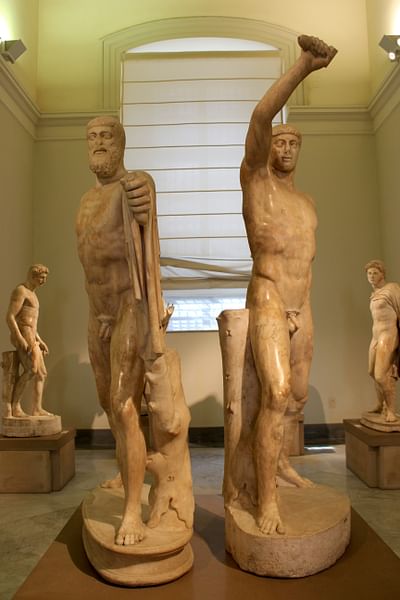
Duke Ling & Mizi Xia
One of the most famous accounts of same-sex couples from ancient China is the story of the relationship between Duke Ling of the State of Wei (r. 534-493 BCE) and the courtier Mizi Xia. The Duke was married and had a son but preferred the company of his male lover. Mizi Xia once borrowed the duke’s carriage without asking permission to go visit his sick mother and, instead of receiving the harsh punishment that anyone else would have been met with, was praised by the duke for his filial piety. Another time, when they were out for a walk, Mizi Xia offered the duke half of a peach he was eating, and the duke was touched, saying, "How great is your love for me. You forget your own appetite and think only of giving me good things to eat!" The phrase "love of the half-eaten peach" became the byword for same-sex relationships afterwards. Both of these events were later reinterpreted by the duke after he had fallen out of love with Mizi Xia who disparaged his former lover saying, "He once took my carriage without asking and offered me a half-eaten peach, so there’s no telling what he might do." The end of their relationship is usually left out of retellings but was actually the main point of the passage by the philosopher Han Feizi (l. c. 280-233 BCE) who was warning courtiers of love affairs with fickle royalty.
The Sacred Band of Thebes
The Sacred Band of Thebes was not one couple but 150, who formed the elite fighting force of 300 comprised of the best warriors of the Theban army. The couples were hand-picked for their military prowess, and the group was formed in the belief that the lover and the beloved would fight to the death to not only protect each other but so they would not appear cowardly and so shame the other in the presence of their brothers-in-arms. The couples all adhered to the classic model of the same-sex relationship in Greece of an older lover caring for and improving the character of a younger beloved, and the name of the unit comes from the vows they took to each other in the name of the god of love, Eros, at the shrine of Iolaus. Although they were formed in c. 379/378 BCE and took part in campaigns prior to 371 BCE, they are regularly referenced as remaining undefeated from the Battle of Leuctra in 371 BCE to the Battle of Chaeronea in 338 BCE when they were overcome by the Macedonians under Philip II (r. 359-336 BCE). Philip II of Macedon is said to have wept at their bravery as they held their ground until they were all slain. The statue of the Lion of Chaeronea is thought to mark their burial site.
Conclusion
There are many more examples of famous same-sex relationships in both ancient history and literature. Among them is the tale of Nisus and Euryalus from books 5 and 9 of the Aeneid of Virgil (l. 70-19 BCE) which, like some of those noted above, is often interpreted as a deep friendship instead of a romantic relationship though it clearly fits the pattern of the latter. Nisus is the older of the couple, the lover, and Euryalus the younger beloved. The two are part of the refugees the hero Aeneas leads to Italy after the fall of Troy, and their story forms part of the battles the Trojans fight against the hostile tribes of the region before establishing the city of Rome. Euryalus is captured by one of these tribes, and Nisus comes to rescue him, but both are killed, falling in defense of each other.
Julius Caesar, Socrates, Plato, Pindar, and many others are referenced as preferring same-sex relationships which, as seen above, were also an accepted expression of affection and sexuality in other cultures. Scholar Colin Spencer comments:
In the ancient world there was no need to distinguish sexual activity with the same gender from that with the opposite gender, nor was any social opprobrium attached to gender at all; instead, ignominy was reserved for passive sexual acts. There was no need for such a word as "homosexuality" because the concept of it did not exist. (10)
The terms "homosexual" and "heterosexual", in fact, were not coined until the 19th century, and both by a gay man, the Austrian writer Karl-Maria Kertbeny (l. 1824-1882) in 1869. Kertbeny came up with the terms in an attempt to normalize and defend same-sex relationships which had been criminalized by the Prussian government. Prior to the rise of Christianity, however, no distinction had ever been made. Kertbeny’s argument for the acceptance of same-sex couples, in fact, would have seemed nonsensical to the ancient, pre-Christian world because they were already so widely accepted.
